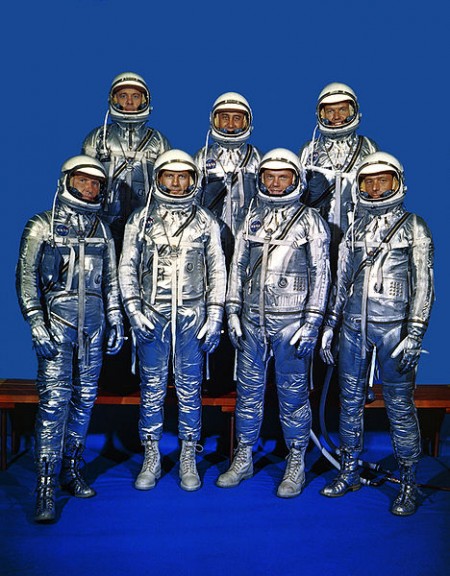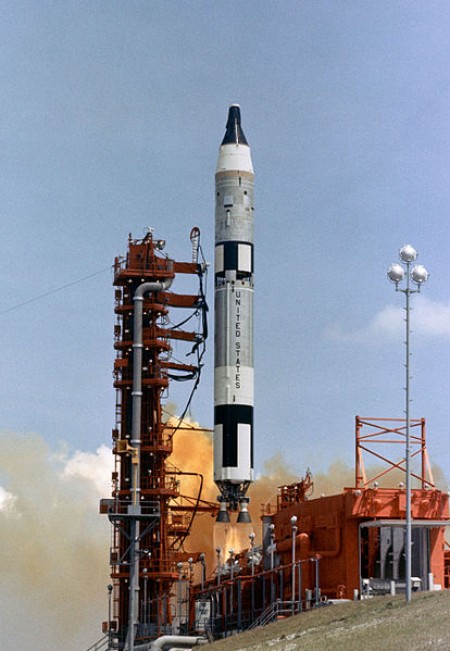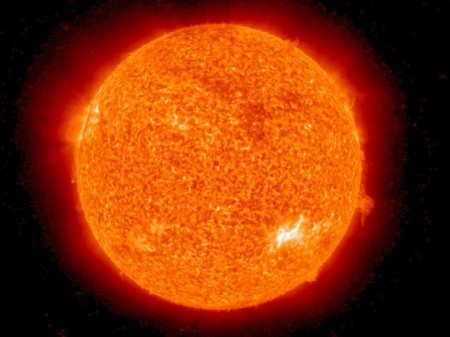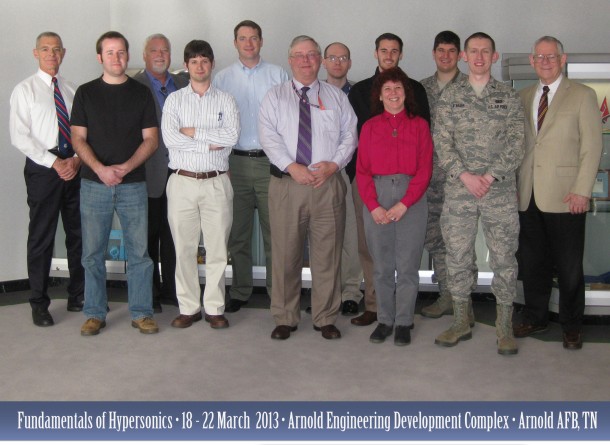
Fifty-two years ago this month, NASA launched Mercury-Atlas 3 (MA-3). While technically a flight test failure, the mission had the unexpected consequence of successfully demonstrating the Mercury spacecraft abort system under realistic emergency flight conditions.
Project Mercury was America’s first manned spaceflight program. Led by the National Aeronautics and Space Administration (NASA), the basic goals of Project Mercury were simple: (1) Orbit a manned spacecraft around the Earth, (2) investigate man’s ability to function in space and (3) recover both man and spacecraft safely.
The guidelines for achieving the above were equally straightforward: (1) Use existing technology and equipment wherever practical, (2) employ the most simple and reliable approach to system design, (3) place the spacecraft into orbit using an existing booster and (4) conduct a progressive and logical test program.
Project Mercury utilized a pair of existing military boosters converted for the manned flight role. The Redstone Intermediate Range Ballistic Missile (IRBM) was used for suborbital missions. Orbital missions were flown using the more powerful Atlas Intercontinental Ballistic Missile (ICBM). Both spacecraft-booster versions were tested a number of times prior to lofting men in to space.
The first suborbital flight test of the Mercury-Atlas combination, Mercury-Atlas 1 (MA-1), was conducted in July of 1960. Unfortunately, the booster structurally failed and exploded about a minute into flight. A second attempt at flying a Mercury-Atlas suborbital mission followed in February of 1961. Things worked out much better this time around as Mercury-Atlas 2 (MA-2) successfully met all test objectives.
The next step in the Mercury-Atlas test series was to attempt at a single orbit mission. This was the primary objective of Mercury-Atlas 3 (MA-3). The subject Mercury spacecraft carried an astronaut simulator intended to mimic the inhalation and exhalation of gas, heat and water vapor characteristics of a man.
On Tuesday, 25 April 1961, Mercury-Atlas 3 lifted-off from Cape Canaveral’s LC-14 at 16:15 UTC. As the vehicle thundered away from the launch pad, all systems functioned as planned. However, the Range Safety Officer (RSO) terminated the mission 43.3 seconds after lift-off as the Atlas launch vehicle began to stray from the intended flight trajectory. The launch vehicle’s autopilot had failed.
Interestingly, the Mercury spacecraft’s abort sensing system and rocket escape system worked exactly as designed. The Mercury spacecraft was safely rocketed away from the exploding booster and lofted to an altitude of 24,000 feet. The parachute recovery system deployed successfully and gently deposited the spacecraft about 4 nm downrange of the launch site. All of this in what was a true in-flight emergency. Had an astronaut been onboard, he would have survived the destruction of the booster.
As a footnote to this story, the Mercury spacecraft flown on MA-3 was found to be in such good condition that it was used for the very next Mercury-Atlas orbital attempt. Happily, that mission, Mercury-Atlas 4 (MA-4) successfully achieved earth orbit and met all flight objectives in September of 1961.

Fifty-four years ago this month, NASA held a press conference in Washington, D.C. to introduce the seven men selected to be Project Mercury Astronauts. They would become known as the Mercury Seven or Original Seven.
Project Mercury was America’s first manned spaceflight program. The overall objective of Project Mercury was very simple: place a manned spacecraft in Earth orbit and bring both man and machine safely back home. Project Mercury ran from 1959 to 1963.
The men who would ultimately become Mercury Astronauts were among a group of 508 military test pilots originally considered by NASA for the new role of astronaut. The group of 508 candidates was then pared to 110, then 69 and finally to 32. These 32 volunteers were then subjected to exhaustive medical and psychological testing.
A total of 18 men were still under consideration for the astronaut role at the conclusion of the demanding test period. Now came the hard part for NASA. Each of the 18 finalists was truly outstanding and would be a worthy finalist. But there were only 7 spots on the team.
On Thursday, 09 April 1959, NASA publicly introduced the Mercury Seven in a special press conference held for this purpose at the Dolley Madison House in Washington, D.C. The men introduced to our nation that day will forever hold the distinction of being the first group of American astronauts. Presented in the order in which they flew, the Mercury Seven were:
Alan Bartlett Shepard Jr., United States Navy. Shepard flew the first Mercury sub-orbital mission (MR-3) on Friday, 05 May 1961. He was also the only Mercury astronaut to walk on the Moon. Shepherd did so as Commander of Apollo 14 (AS-509) in February 1971. Alan Shepard succumbed to leukemia on 21 July 1998 at the age of 74.
Vigil Ivan (“Gus”) Grissom, United States Air Force. Grissom flew the second Mercury sub-orbital mission (MR-4) on Friday, 21 July 1961. He was also Commander of the first Gemini mission (GT-3) in March 1965. Gus Grissom might very well have been the first man to walk on the Moon. But he lost his life in the Apollo 1 Fire, along with Astronauts Edward H. White II and Roger B. Chaffee, on Friday, 27 January 1967. Gus Grissom was 40 at the time of his death.
John Herschel Glenn Jr., United States Marines. Glenn was the first American to orbit the Earth (MA-6) on Thursday, 22 February 1962. He was also the only Mercury Astronaut to fly a Space Shuttle mission. He did so as a member of the STS-95 crew in October of 1998. Glenn was 77 at the time and still holds the distinction of being the oldest person to fly in space. John Glenn will be 92 in July 2013.
Malcolm Scott Carpenter, United States Navy. Carpenter became the second American to orbit the Earth (MA-7) on Thursday, 24 May 1962. This was Carpenter’s only mission in space. He subsequently turned his attention to under-sea exploration and was an aquanaut on the United States Navy SEALAB II project. Scott Carpenter will be 88 in May 2013.
Walter Marty Schirra Jr., United States Navy. Schirra became the third American to orbit the Earth (MA-8) on Wednesday, 03 October 1962. He later served as Commander of Gemini 6A (GT-6) in December 1965 and Apollo 7 (AS-205) in October 1968. Schirra was the only Mercury Astronaut to fly Mercury, Gemini and Apollo orbital spaceflight missions. Wally Schirra suffered a heart attack in May 2007 and passed away at the age of 84.
Leroy Gordon Cooper Jr., United States Air Force. Cooper became the fourth American to orbit the Earth (MA-9) on Wednesday, 15 May 1963. In doing so, he flew the last and longest Mercury mission (22 orbits, 34 hours). Cooper was also Commander of Gemini 5 (GT-5), the first long-duration Gemini mission, in August 1965. Gordo Cooper died from heart failure in October 2004 at the age of 77.
Donald Kent Slayton, United States Air Force. Slayton was the only Mercury Astronaut to not fly a Mercury mission when he was grounded for heart arrythemia in 1962. He subsequently served many years on Gemini and Apollo as head of astronaut selection. He finally got his chance for spaceflight in July 1975 as a crew member of the Apollo-Soyuz mission (ASTP). Deke Slayton died from brain cancer in June of 1993 at the age of 69.
History records that the Mercury Seven was the only group of NASA astronauts that had a member who flew each of America’s manned spacecraft (i.e, Mercury, Gemini, Apollo and Shuttle). Though just men and imperfect mortals, we salute each of them for their genuinely heroic deeds and unique contributions made to the advancement of American manned spaceflight.

Forty-nine years ago this month, the first of two NASA Project FIRE flights to acquire aerodynamic heating flight data on a subscale Apollo reentry vehicle was successfully flown. The mission provided vital aerothermodynamics data needed by the Apollo Program to evaluate heatshield materials and communications blackout phemomena for superorbital reentry of the Apollo Command Module.
The rapid advancement of manned space exploration in the 1960’s accentuated the need for defining the reentry heating environment at velocities exceeding the earth’s escape velocity. The primary objective of Project FIRE (Flight Investigation of the Reentry Environment) was to obtain convective and radiative aerodynamic heating data for a subscale reentry vehicle representative of the Apollo Command Module.
The Project FIRE concept involved the use of an Atlas D launch vehicle to loft the FIRE spacecraft into a suborbital flight path. During the post-apogee leg of this trajectory, an Antares II solid-fuel upper stage fired and drove the payload to maximum velocity. Instruments within the FIRE spacecraft measured and radioed data to the ground all the way to splash. There was no attempt to recover the payload.
The heating pulse for a FIRE reentry lasted about 40 seconds. However, a single calorimeter could not survive the entire entry heating period. As a solution to this problem, NASA engineers developed an innovative, but complex, 6-layer heat shield to measure the convective and radiative heat flux rates throughout the heating pulse.
The first, third and fifth layers of the FIRE forebody heat shield were made from beryllium and instrumented with thermocouples to obtain reentry temperature-time histories. The second, fourth and sixth layers consisted of phenolic asbestos thermal protection material. The first two of these latter layers were jettisoned at appropriate times during the entry heating pulse to expose a fresh calorimeter to a clean environment.
Radiometers measured total radiant heat flux through quartz windows mounted in each forebody layer. One each was located in the stagnation region and near corner of the front face of the base heat shield. The short life of these radiometer quartz windows limited acquisition of radiant heat flux data to three brief periods during the heating pulse.
On Tuesday, 14 April 1964, an Atlas D launch vehicle carrying the FIRE 1 spacecraft lifted-off from Cape Canaveral’s LC-12 at 21:42:25 UTC. A ballistic trajectory was flown down the Eastern Test Range (ETR). The maximum velocity and flight path angle achieved during the mission was 37,790 feet per second and -14.5 degrees, respectively. Payload impact occurred in the South Atlantic Ocean near Ascension Island. Total flight time from launch to splash was on the order of 32 minutes.
From a trajectory and sequence-of-events standpoint, FIRE 1 was a complete susccess, since the vehicle performance and timed events were well within prescribed limits. However, a faulty telemetry antenna and unexpectedly large coning motions of the FIRE spacecraft complicated data acquisition and interpretation.
Maximum flight-measured heating rate on the FIRE spacecraft forebody was 1,003 BTU’s per square foot per second, which agreed well with ground test and theory. Incredibly, the spacecraft exterior reached an estimated temperature of 20,000 degrees Fahrenheit; hotter than the outer surface of the Sun.

Forty-nine years ago today, NASA successfully conducted the orbital mission of Gemini-Titan 1. The unmanned test marked the first time that a modified Titan II ICBM launch vehicle was used to loft a Gemini spacecraft into earth orbit.
Project Mercury was America’s first manned spaceflight series. Project Apollo would ultimately land men on the Moon and return them safely to the Earth. In between these historic spaceflight efforts would be Project Gemini.
The purpose of Project Gemini was to develop and flight-prove a myriad of technologies that were required to get to the Moon. Those critical technologies included spacecraft power systems, rendezvous and docking, orbital maneuvering, long duration spaceflight and extravehicular activity.
Gemini-Titan 1 (GT-1) was the first flight of the Gemini Program. The primary goals of the mission were to (1) verify the structural integrity of the Gemini spacecraft-Titan II booster combination, (2) exercise the program’s new tracking and communication systems, and (3) provide realistic training for Gemini ground support crews.
The Gemini I spacecraft did not carry a crew. Thus, it was not configured with a life support system nor crew seats . Rather, the vehicle carried equipment for measuring flight pressure, vibration, acceleration, temperature, and structural loads data. These test measurements were telemetered to the ground during the flight for later analysis.
The Titan II was designed as an Intercontinental Ballistic Missile (ICBM). In its new role as a manned launch vehicle, the Titan II’s reliability had to be improved substantially before commiting a human crew to flight. Like the Redstone and Atlas missiles converted for the manned launcher role in the Mercury Program, this demanding task would be successfully completed in the case of the Titan II as well.
On Wednesday, 08 April 1964, Gemini-Titan 1 lifted-off at 16:01:01.69 UTC from Cape Canaveral’s LC-19. It only took about 330 seconds for the Gemini spacecraft to be inserted into an elliptical orbit measuring 165 nm (apogee) by 87 nm (perigee). The Titan second stage would remain attached to the Gemini spacecraft throughout the mission.
The GT-1 mission was officially completed after three (3) earth orbits encompassing slightly under 5 hours of flight. However, the combined spacecraft-second stage configuration remained in space for 95 hours before reentering the earth’s atmosphere during orbit 64. By design, the vehicle did not survive the fiery reentry. Debris impact occurred in the South Atlantic around 15:00 UTC on Sunday, 12 April 1964.
Although certainly not problem free, Gemini-Titan 1 successfully satisfied mission objectives and provided confidence in both the Gemini spacecraft and the Titan II booster. Another successful unmanned mission (GT-2) would follow in January 1965. The technical know-how gleaned from these early unmanned flights led to the first manned Gemini mission (GT-3) which was successfully flown in March 1965.

Washington DC, 01 April 2013 – In a bold new initiative intended to revitalize a flagging American human spaceflight program, government officials today announced plans to land a team of astronauts on the Sun by the year 2038.
The stunning announcement immediately evoked comparisons to the glory days of the Apollo lunar landing effort. Public reaction to this next great adventure in space was overwhelmingly favorable. However, talk of a resurgence in American space supremacy failed to sway federal lawmakers whose collective response could best be described as tepid.
Responding to claims in some sectors that the benefit-to-risk ratio is far too low for such a mission, the space agency immediately countered that unusually extreme measures are being taken to mitigate mission risk. Reportedly, a key element of the risk mitigation plan involves scheduling the solar landing at night. Moreover, each astronaut will be equipped with a personal fire extinguisher and also receive the equivalent of a masters degree in fire science by way of pre-flight training.
Crew creature comforts are also a high priority for the solar landing mission. Citing as proof that the space agency has done their homework here as well, officials indicated that the landing party will be provided with more than ample supplies of sunscreen (SPF 1 Million), sun glasses (welder’s glass), and asbestos undergarments.
Amidst a flurry of early speculation regarding the prime crew for the first solar landing attempt, the most frequently mentioned names are those of Gollum, Cruella De Vil, and Count Rugen. Back-up crew members include the Wicked Witch of the North, the Joker, and a player to be named later. While space officials declined to provide details, the competition for a seat on this daring mission is understandably intense.
It is not obvious at this writing as to how the solar landing team will actually get to the Sun. The United States (1) has not flown a Saturn V launch vehicle since 1973, (2) retired the Space Shuttle in 2011, (3) currently has no manned-rated launch system, and (4) must rely on Russia to get to and from its own space station. However, a senior space official requesting anonymity avers that alien abduction is a leading contender for transport to the Sun.
Challenging too is the question of how astronauts will travel on the surface of the Sun where temperatures are on the order of 10,000F. A possible solution to this vexing problem comes by way of the automobile industry which has suggested the use of an all-electric version of the Chevy Volt. Government officials have been swift to agree. Not only is there a reduction of fire and explosion hazard due to elimination of combustible fuels, but there is the additional benefit of taking the green movement to the Sun.
One simplifying feature of the solar landing mission is that there is no return flight. Thus, the technical complexities and substantial costs associated with lift-off from the Sun, trans-earth trajectory, and atmospheric entry back at Earth are eliminated. Environmentalists were especially pleased to hear that entry vehicle aerodynamic heating would not be a factor on this mission. The fear being that such heating would markedly contribute to man-made global warming or whatever the climate change crisis du jour.
That’s our report for now. Suffice it to say that uncommon days lie ahead for the American human spaceflight program. To stay abreast of the latest solar landing project developments, the interested reader is directed to the following URL: AprilFool.com
J. Terry White just taught two back-to-back short courses to a group of top-notch professionals from Arnold Engineering Development Complex (AEDC). AEDC is located at Arnold Air Force Base in Tennessee and is the most advanced and largest complex of flight simulation test facilities in the world.
From 18-22 March, Mr. White held a repeat offering of his Fundamentals of Hypersonics (FOH) course at AEDC. The initial offering of FOH to AEDC personnel was held 13-17 August 2012. The FOH course provides a thorough treatment of hypersonic flow physics, gas dynamics, aerodynamic heating, plasma effects, aeroacoustics and flight vehicle force and moment characteristics. One student elaborated on the usefulness of the course, saying “The overview of multiple aspects of hypersonics in this course provides context for specific applications of interest or particular fields of study. Even if you are an expert in the fundamentals of hypersonic flight, the course is worthwhile for the technical and historical briefs alone.”

From 25-28 March, Mr. White taught his Basic Missile Aerodynamics (BMA) course. The course provides expert instruction in the fundamentals of missile aerodynamics as applied to airframe design and test, with direct application across a broad spectrum of missile types including tactical missiles, ballistic missiles, launch vehicles, sounding rockets and projectiles. One kind student remarked on the learning experience, saying the course was “The most professional, concise and comprehensive course on aerodynamics I’ve ever taken. This course restored enthusiasm in flight that I had lost since graduating from my undergraduate program.”

White Eagle Aerospace strives to build and maintain a team of aerospace experts who are passionate about the subjects they teach – and equally passionate about teaching. Mr. White leads the team with an astounding love for what he does and found the two-week teaching experience at AEDC to be exceptionally rewarding. He said, “AEDC has always been connected to what’s happening in aerospace and this continues to be the case. It is a privilege teaching the professionals at the world’s preeminent ground test facility.”
The WEA team extends sincere gratitude to each of the students who attended the recent classes at AEDC, in addition to Ms. Dee Wolfe, Ms. Jeannie McFaddin and Mr. Don Malloy for their priceless assistance.







